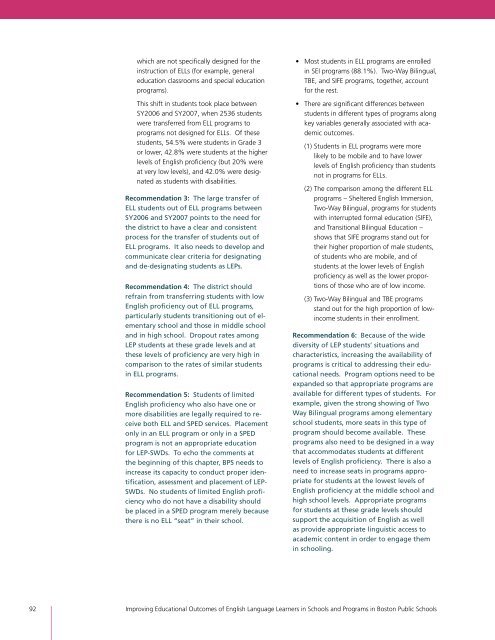Full Report - Center for Collaborative Education
Full Report - Center for Collaborative Education
Full Report - Center for Collaborative Education
You also want an ePaper? Increase the reach of your titles
YUMPU automatically turns print PDFs into web optimized ePapers that Google loves.
which are not specifically designed <strong>for</strong> the<br />
instruction of ELLs (<strong>for</strong> example, general<br />
education classrooms and special education<br />
programs).<br />
This shift in students took place between<br />
SY2006 and SY2007, when 2536 students<br />
were transferred from ELL programs to<br />
programs not designed <strong>for</strong> ELLs. Of these<br />
students, 54.5% were students in Grade 3<br />
or lower, 42.8% were students at the higher<br />
levels of English proficiency (but 20% were<br />
at very low levels), and 42.0% were designated<br />
as students with disabilities.<br />
Recommendation 3: The large transfer of<br />
ELL students out of ELL programs between<br />
SY2006 and SY2007 points to the need <strong>for</strong><br />
the district to have a clear and consistent<br />
process <strong>for</strong> the transfer of students out of<br />
ELL programs. It also needs to develop and<br />
communicate clear criteria <strong>for</strong> designating<br />
and de-designating students as LEPs.<br />
Recommendation 4: The district should<br />
refrain from transferring students with low<br />
English proficiency out of ELL programs,<br />
particularly students transitioning out of elementary<br />
school and those in middle school<br />
and in high school. Dropout rates among<br />
LEP students at these grade levels and at<br />
these levels of proficiency are very high in<br />
comparison to the rates of similar students<br />
in ELL programs.<br />
Recommendation 5: Students of limited<br />
English proficiency who also have one or<br />
more disabilities are legally required to receive<br />
both ELL and SPED services. Placement<br />
only in an ELL program or only in a SPED<br />
program is not an appropriate education<br />
<strong>for</strong> LEP-SWDs. To echo the comments at<br />
the beginning of this chapter, BPS needs to<br />
increase its capacity to conduct proper identification,<br />
assessment and placement of LEP-<br />
SWDs. No students of limited English proficiency<br />
who do not have a disability should<br />
be placed in a SPED program merely because<br />
there is no ELL “seat” in their school.<br />
• Most students in ELL programs are enrolled<br />
in SEI programs (88.1%). Two-Way Bilingual,<br />
TBE, and SIFE programs, together, account<br />
<strong>for</strong> the rest.<br />
• There are significant differences between<br />
students in different types of programs along<br />
key variables generally associated with academic<br />
outcomes.<br />
(1) Students in ELL programs were more<br />
likely to be mobile and to have lower<br />
levels of English proficiency than students<br />
not in programs <strong>for</strong> ELLs.<br />
(2) The comparison among the different ELL<br />
programs – Sheltered English Immersion,<br />
Two-Way Bilingual, programs <strong>for</strong> students<br />
with interrupted <strong>for</strong>mal education (SIFE),<br />
and Transitional Bilingual <strong>Education</strong> –<br />
shows that SIFE programs stand out <strong>for</strong><br />
their higher proportion of male students,<br />
of students who are mobile, and of<br />
students at the lower levels of English<br />
proficiency as well as the lower proportions<br />
of those who are of low income.<br />
(3) Two-Way Bilingual and TBE programs<br />
stand out <strong>for</strong> the high proportion of lowincome<br />
students in their enrollment.<br />
Recommendation 6: Because of the wide<br />
diversity of LEP students’ situations and<br />
characteristics, increasing the availability of<br />
programs is critical to addressing their educational<br />
needs. Program options need to be<br />
expanded so that appropriate programs are<br />
available <strong>for</strong> different types of students. For<br />
example, given the strong showing of Two<br />
Way Bilingual programs among elementary<br />
school students, more seats in this type of<br />
program should become available. These<br />
programs also need to be designed in a way<br />
that accommodates students at different<br />
levels of English proficiency. There is also a<br />
need to increase seats in programs appropriate<br />
<strong>for</strong> students at the lowest levels of<br />
English proficiency at the middle school and<br />
high school levels. Appropriate programs<br />
<strong>for</strong> students at these grade levels should<br />
support the acquisition of English as well<br />
as provide appropriate linguistic access to<br />
academic content in order to engage them<br />
in schooling.<br />
92 Improving <strong>Education</strong>al Outcomes of English Language Learners in Schools and Programs in Boston Public Schools


